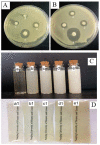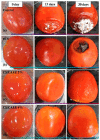Chitosan Based Biodegradable Composite for Antibacterial Food Packaging Application
- PMID: 37242810
- PMCID: PMC10223533
- DOI: 10.3390/polym15102235
Chitosan Based Biodegradable Composite for Antibacterial Food Packaging Application
Abstract
A recent focus on the development of biobased polymer packaging films has come about in response to the environmental hazards caused by petroleum-based, nonbiodegradable packaging materials. Among biopolymers, chitosan is one of the most popular due to its biocompatibility, biodegradability, antibacterial properties, and ease of use. Due to its ability to inhibit gram-negative and gram-positive bacteria, yeast, and foodborne filamentous fungi, chitosan is a suitable biopolymer for developing food packaging. However, more than the chitosan is required for active packaging. In this review, we summarize chitosan composites which show active packaging and improves food storage condition and extends its shelf life. Active compounds such as essential oils and phenolic compounds with chitosan are reviewed. Moreover, composites with polysaccharides and various nanoparticles are also summarized. This review provides valuable information for selecting a composite that enhances shelf life and other functional qualities when embedding chitosan. Furthermore, this report will provide directions for the development of novel biodegradable food packaging materials.
Keywords: antimicrobial activity; biodegradable chitosan film; chitosan; composites; food packaging.
Conflict of interest statement
The authors declare no conflict of interest.
Figures









References
-
- Ramos M., Valdés A., Beltrán A., Garrigós M.C. Gelatin-Based Films and Coatings for Food Packaging Applications. Coatings. 2016;6:41. doi: 10.3390/coatings6040041. - DOI
-
- Flórez M., Guerra-Rodríguez E., Cazón P., Vázquez M. Chitosan for food packaging: Recent advances in active and intelligent films. Food Hydrocoll. 2022;124:107328. doi: 10.1016/j.foodhyd.2021.107328. - DOI
Publication types
LinkOut - more resources
Full Text Sources

